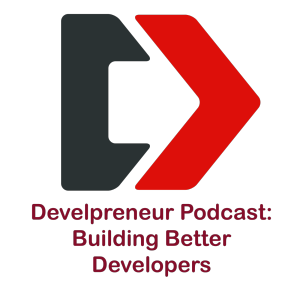
Develpreneur: Become a Better Developer and Entrepreneur
Technology Podcasts
This podcast is for aspiring entrepreneurs and technologists as well as those that want to become a designer and implementors of great software solutions. That includes solving problems through technology. We look at the whole skill set that makes a great developer. This includes tech skills, business and entrepreneurial skills, and life-hacking, so you have the time to get the job done while still enjoying life.
Location:
United States
Genres:
Technology Podcasts
Description:
This podcast is for aspiring entrepreneurs and technologists as well as those that want to become a designer and implementors of great software solutions. That includes solving problems through technology. We look at the whole skill set that makes a great developer. This includes tech skills, business and entrepreneurial skills, and life-hacking, so you have the time to get the job done while still enjoying life.
Twitter:
@develpreneur
Language:
English
Contact:
6159740442
Website:
https://develpreneur.com/
Email:
info@develpreneur.com
How Value-Driven Project Discovery Shapes Better Software Outcomes
Duration:00:31:54
How Story-Driven Discovery in Software Projects Leads to Better Results
Duration:00:32:49
Managing Digital Distractions: Insights from Mister Productivity (Part 2)
Duration:00:34:29
Staying Focused in a Noisy World: Lessons from Mr. Productivity (Part 1)
Duration:00:30:00
Thanksgiving Reflections for Developers: A Moment to Reset and Appreciate
Duration:00:15:01
Thanksgiving Tips for Developers: How to Reset, Recharge, and Enjoy the Holiday Break
Duration:00:17:51
Fixed Bid vs Time and Materials: Insights from Our Interview with Charly Leetham (Part 2)
Duration:00:24:26
Strategic Foundations for Business Growth – Interview with Charly Leetham (Part 1)
Duration:00:33:15
Automating Quality: Greg Lind on AI, Testing, and Continuous Improvement
Duration:00:31:07
Bridging the Gap Between Product and Development: Building Better Foundations with Greg Lind
Duration:00:33:11
WordPress SEO for Developers: Tools vs. Building Your Own with Wes Towers (Part 2)
Duration:00:31:52
Niching for Developers: Lessons from Wes Towers (Part 1)
Duration:00:30:40
Strong Foundations Start with Strong Requirements
Duration:00:24:30
Vibe Coding Is Changing the Way Developers Build Software
Duration:00:20:41
Refining the Remote Hiring Process with Agustin Morrone of Vintti (Part 2)
Duration:00:27:53
Redefining Remote Hiring with Agustin Morrone of Vintti (Part 1)
Duration:00:28:17
Branding and Marketing Fundamentals with Kevin Adelsberger
Duration:00:34:47
Branding Basics: Building a Strong Foundation with Kevin Adelsberger
Duration:00:30:25
Trust and Reliability Matter: Interview with Adam Malone (Part 2)
Duration:00:28:30
The Power of Trust: Interview with Adam Malone (Part 1)
Duration:00:37:45